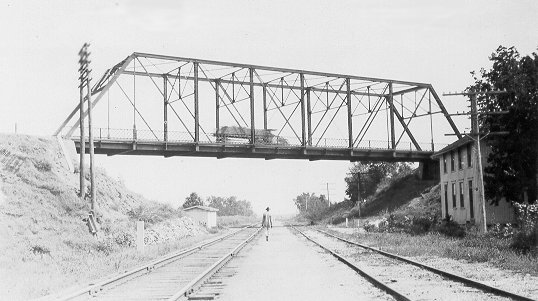|
CAMELBACK PONY TRUSS
c1910-15 Kay 36E0280N3210003
1911 LeFlore 40E1570N4480006 Kansas City Br.
1913 Craig 18E1570N4430001 Illinois Steel Br.
1920 Logan 42N3210E0800007
1923 Pittsburg 61E1570N4080003 Campbell Bros.
1929 Jackson 33E1643N2170005 Western Const.
1933 Canadian 0902 0000X Kansas City Br.
1939 Jefferson 3416 0050X Virginia Br.
The camelback truss contended for the title of the most popular derivation from the standard Pratt design. What engineers came to like about this type was its characteristic feature of precisely five angles in the upper chord that permitted greater standardization and better predictable
ity on how the structure would behave in service. As with other polygonal top chords, this design made possible longer spans and more economical use of metal. The state highway department, reconizing their advantages, made extensive use of camelbacks, building hundreds of them on state and federal highways. Most of them followed the standard specifications which the department began to draft in the early 1920s for spans of varying lengths. Builders found the greatest use for the 80 and 100 foot types; all specified riveted connections. Illustrating the impact of the department's adoption of the standard camelback after the First World War, of the 173 remaining examples, 98% were erected since 1920. With pinned camelbacks rare by comparison, two stand out: a 92-foot bridge built about 1910-1915 in Kay County and a 150-foot span--pinned because of its greater length--across Bear Creek east of Guthrie.
A powerful demonstration of the strength and versitility of the standard-design camelback pony occurred in 1933 when the state aquired its longest bridge, 3,944 feet, by amking use of thirty-eight 100-foot camelbacks to carry U.S. 66 over the South Canadian River. This huge project near Bridgeport, a site previously used by automobile and railroad spans, also showed the industrial and technical abilities of the contractor, Kansas City Bridge Company, one of the old-line firms that had built steel trusses in Oklahoma from the earliest days. The confidence of engineers in camelbacks for big projects may have developed from constructing a twenty-three span bridge over the North Fork of the Red River in 1929 on old U.S. 62, a principal east-west route. Ten years later, twenty-one 100-foot camelbacks formed the Red River bridge near Waurika to connect important oil regions in Oklahoma and Texas. This bridge employed heavier weight laced channel and I-beams for structural members (Figure 53).

Figure 53. Standard 100-foot camelback spans form Bridge 3416 0050X over the Red River in Jefferson County.
|



